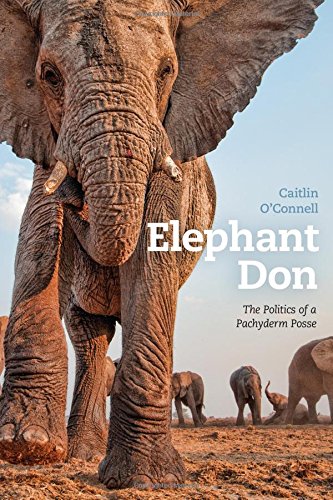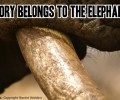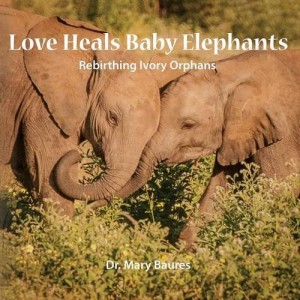Elephant Don, the Politics of the Pachyderm Posse Book Review with Author Interview
It’s been said that every great love starts with a great story. In her newest book Elephant Don, the Politics of the Pachyderm Posse, Dr. Caitlin O’Connell takes readers into a great story of living with the elephant bulls of Mushara, Namibia. The book is accessible to anyone and is definitely not just a read for wildlife enthusiasts. Caitlin said, “As a scientist, I try to bridge the gap between science and the public in many different ways.”And by the end of the book, the reader will definitely develop a greater understanding of, and a greater love for, elephants.
Bulls in musth fighting (Beckham and Prince Charles pictured here) Photograph shared with permission copyright O’Connell & Rodwell
Once thought to be loners in the wild, Caitlin’s research now shows that in fact bull elephants form social networks to help “raise” young bulls that find themselves pushed out of the matriarchal herds. As young bulls enter their teenage years (a chapter aptly titled “Teenage Wasteland”), they become aggressive with their sisters and mothers and are forced out of the herd. Therefore, it is imperative for them to find older, wiser bulls to teach them where to find food and water (especially in years of drought) and to keep their hormones in check during musth (the mating phase) when the bull’s testosterone levels shoot up to 20 times higher than normal. When a bull is in this constant state of arousal, dribbling urine, slapping his ears and stamping his feet, older bulls will shove and head butt these younger bull which often lowers their testosterone levels. A process known as “socially induced hormone suppression” has been documented in other species, and now O’Connell hypothesizes that this disciplinary action is present in elephants.
I specifically asked Caitlin about her thoughts on elephants in captivity with regards to how the often live in isolation. She said she hopes,
that my book draws attention to is the fact that male elephants are very social animals and in captivity. should be given the opportunity to be social. Often males are kept in isolation.
I also asked Dr. O’Connell about living with the elephants for an extended period of time and how the “observer effect” changes how the elephants might act under supervision of humans. She replied
We go to great lengths to conceal our visual presence and when elephants are present we remain hidden in either a tower or bunker. Although they can smell our presence, they have fully habituated to the scent of humans as they live in a national park where they experience the presence of rangers and tourists and vehicles regularly. The fact that they make the decision to approach us rather than us approaching them is an added level of caution. If approached, they might feel threatened but if they approach, they are more comfortable. Art this point in our studies, elephants are used to a presence at our field site during the winter months.
Aerial photograph of the Mushara camp. Photograph shared with permission copyright O’Connell & Rodwell
Although the elephants are given numbers that are catalogued for research, Caitlin also gives them names based on at least one physical feature. Maybe not the intent of O’Connell, by assigning names to these bulls, readers find themselves connecting with these magnificent animals as individuals rather than just scientific case studies. There are elephants named Willie Nelson, Prince Charles, and even Ozzy Osbourne. Caitlin says William Nelson is very raggedy, and as one might guess, Ozzy has an unusually long, black and scraggly tail. I particularly enjoyed following the story line of Smokey and would love to know who your favorite bull from the “boys club” is after you read the book!
The Pachyderm Posse led by Greg (in the middle). Photograph shared with permission copyright O’Connell & Rodwell
The leader of the pachyderm posse is Greg. But how did he become the leader? How long will he be in charge? Was it partly due to nurture and the family he was born into? Or was it purely through natural selection and fighting to the top? These are just a few of the questions Caitlin’s research looks to answer. She states,
Greg is not the biggest bull, not the oldest, and he doesn’t have the biggest tusks. He is very strong-willed and he is a great politician. He is the most felicitous and gentle dominant bull that I’ve witnessed. He actively solicits the young bulls and gets them into the fold and welcomes them. He’s also very quick to discipline someone who gets out of line in the higher ranks. It’s like he knows how to manage the carrot and the stick.
Hence Greg is the Elephant “Don,” the leader of the pack, the one who seems to keep the posse in check. Over the years she studied these relationships, this overarching theme stood out to me: the importance of community, and especially the presence of the elder bulls in the lives of younger bulls. With the increase in poaching (and hunting), these are the bulls most frequently targeted. Yet, these are the bulls that are critical to the survival of the next generation elephants! As Caitlin said,
The big, older bulls are targets of poaching. People think of lone bulls out there, and they might think, “What is it going to hurt a population if you cull a few of those elephants?” But these old males are similar to matriarchs. They are repositories of knowledge, and they teach the next generation.
Caitlin’s nonprofit Utopia Scientific created poaching detection device for the remote waterholes she studies to keep the elephants protected. Luckily, she says these elephants have not yet been targeted by poachers. When I asked her for her thoughts on whether ivory should be legalized or banned, she replied that I should read her newest book Ivory Ghosts, a fiction piece about the ivory wars. Although it’s fiction, she said she was inspired to write the thriller Ivory Ghosts to convey the complexities of elephant conservation on the ground as well as the poaching crisis based on her 20+ years of experience working with elephant conservation in Africa. It’s on my kindle now, and I look forward to starting it. Because if it is true that every great love starts with a great story, then books like these need to be read and shared!
While Abe drinks, Willie approaches and places his trunk in Abe’s mouth, a respectful ritual akin to akin to kissing the ring of Mafioso Don. Photograph shared with permission copyright O’Connell & Rodwell
Many thanks to Dr. Caitlin O’Connell for taking the time to answer my plethora of questions! Below are a few fascinating facts she shared with me:
Me: At Mushara, you mentioned that the females often came to the water hole at night while the bulls came during the day. Why?
Caitlin: I believe it is because sound transmission is better at night and females feel safer traveling when they can access their environment acoustically and coordinate movements with extended family in low wind conditions.
Me: It seems like it is common for bull elephants to break tusks? How does this alter how you estimate their age (because usually tusk length is an indicator of age?) Is it painful for a tusk to break? Could rangers break elephants tusks to keep poachers away?
Caitlin: There is a mineral deficiency in the soil in the region I conduct my studies which is why tusks break more often there. Normally tusks don’t break that often and no, Rangers can certainly not break them! Not only is it dangerous but they could break the tusk to the nerve which would be incredibly painful and possibly lethal. There has been talk of darting elephants and cutting the tusks to deter poaching but there is still plenty of tusk beyond the tooth nerve so that is not a viable option and is also expensive because tusks grow back (albeit at a slow rate).
Elephant age is not determined by tusk length. The diameter of the base of the tusks can help with age estimates but shoulder height is what is commonly used as well as hind foot length (or tooth ware if one has access to that information, usually on a dead elephant, or in a situation where a cast can be made).
Me: Why do elephants lay their trunk on the ground?
Caitlin: This question is the subject of my first science memoir, The Elephants Secret Sense. Elephants have vibration-sensitive cells in their trunks and lay their trunks on the ground to detect the whereabouts of other elephants or potential danger such as a vehicle approach.
Me: Studying elephants year after year in the same location, have you noticed the effects of climate change on their habitat?
Caitlin: Our field site is subject to El Niño patterns. In drier years, in order to minimize competition for access to water, male elephants form linear dominance hierarchies within large groups. In Wet years, group sizes are smaller and ranking less linear. So, yes, environmental fluctuations do effect social structure. If the environment gets drier over a period of time, I would predict that elephants would maintain a strict dominance hierarchy, and if resources become particularly scarce, such has not having enough water to drink, diplomacy would break down and only the strongest and highest ranking would be able to compete for access. Other species would especially suffer as elephants can successfully chase other animals away from a limited water supply.
Me: You mentioned the teams that go on these annual trips with you - are they open to any volunteers? How are they selected?
Caitlin: Volunteering is opened and individuals selected based on very limited availability and skill sets, experience and interest level of potential participant. The program is supported by these few volunteers that contribute to the cost of running the program. Please contact us through our nonprofit website www.utopiascientific.org
Me: What words of advice might you have for elephant advocates around the world who are looking to help end the ivory trade and save elephants?
Caitlin: My advice is to talk to people on both sides of the argument so that one can be as informed as possible and help make the best impact.









